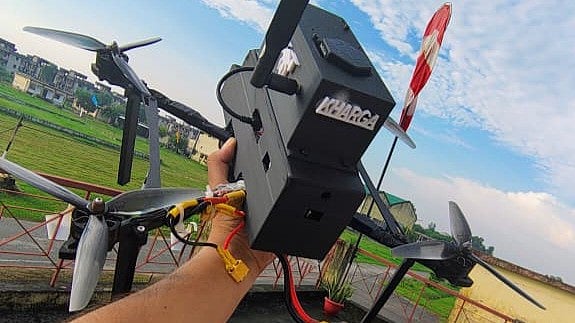**Innovative Drone Project by Satna Resident for Indian Army**
Satna (Madhya Pradesh): Anshuman Shukla, a resident of the Kitaha area in Satna district, has developed two advanced drones for the Indian Army designed to neutralize enemy targets. These drones successfully passed testing at the campus of the 609 EME Battalion in Meerut district, Uttar Pradesh.
Currently, Anshuman is working on enhancing the drones’ operational range. Alongside him, his two friends, Abhijit Patel and Akhilesh Singh Rathore, are actively involved in the project.
The Government of India has announced that this initiative is part of **Operation Sindoor**, under which the manufacturing of these drones is underway. One drone is specifically built for attacking enemy positions, while the other is designated for post-mission damage assessment.
Anshuman, the son of contractor Anil Shukla, was inspired to develop these drones following the Russia-Ukraine conflict. He is pursuing a Bachelor of Engineering in Mechanical Engineering at the Institute of Engineering Technology, Indore.
The team handed over their project to Lieutenant Colonel Nitin Verma of the 609 Battalion. The development spanned from August 10 to September 5, during which the trio stayed at the army camp to complete the work.
Both drones are equipped with modern systems, featuring SIM cards that enable activation from anywhere in the world via Short Message Service (SMS). Currently, the drones have a maximum range of 20 km, a significant improvement over existing drones that typically have a 5 km range. Their top speed reaches 180 km/h.
Anshuman explained that the attack drone is designed to self-destruct after completing its mission to avoid capture. The surveillance drone, meanwhile, is fitted with a night vision camera to estimate damage inflicted on the enemy.
The drones boast a portable, lightweight design and were developed with a total expenditure of Rs 3 lakh. They take off from altitudes of 100-200 metres, keeping them below radar detection, and operate at a flying height of approximately 400 metres above ground level.
Each drone can carry between 2 to 4 kilograms of explosives, making them highly effective tactical tools for the battlefield.
This pioneering project marks a significant contribution from young innovators towards strengthening India’s defense capabilities.
https://www.freepressjournal.in/bhopal/drones-made-by-mps-satna-boy-pass-test-at-army-camp
